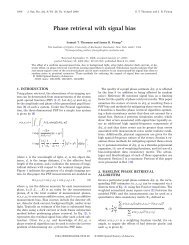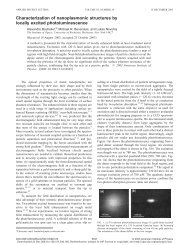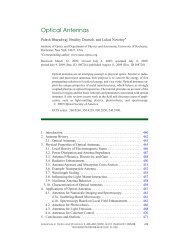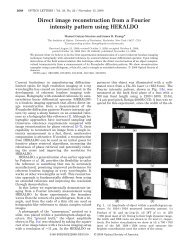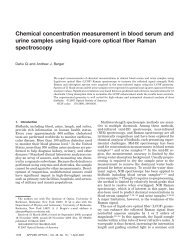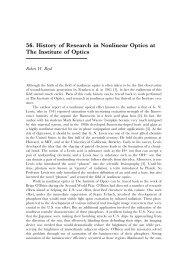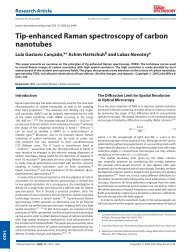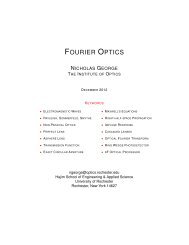Honeycomb Pattern Formation by Laser-Beam Filamentation in Atomic
Honeycomb Pattern Formation by Laser-Beam Filamentation in Atomic
Honeycomb Pattern Formation by Laser-Beam Filamentation in Atomic
Create successful ePaper yourself
Turn your PDF publications into a flip-book with our unique Google optimized e-Paper software.
VOLUME 88, NUMBER 11 PHYSICAL REVIEW LETTERS 18MARCH 2002<br />
beams more than three spots are created. In perform<strong>in</strong>g the<br />
calculation shown <strong>in</strong> Fig. 4, we took the <strong>in</strong>put beam to have<br />
a peak <strong>in</strong>tensity of 4 times the saturation <strong>in</strong>tensity and took<br />
the <strong>in</strong>put (Gaussian) beam diameter to be 130 mm, where<br />
the measured value is 180 mm. This agreement is quite<br />
reasonable <strong>in</strong> light of the fact that our theoretical model<br />
does not treat the multilevel structure of the sodium atom.<br />
In summary, we have observed a dramatic example of<br />
optical pattern formation <strong>in</strong> which a s<strong>in</strong>gle laser beam<br />
propagat<strong>in</strong>g through atomic sodium vapor without feedback<br />
develops a stable, regular transverse structure. In<br />
particular, a three-filament near-field pattern lead<strong>in</strong>g to a<br />
honeycomb far-field pattern occurs at <strong>in</strong>tensities near the<br />
saturation <strong>in</strong>tensity and at powers larger than (but of the<br />
order of magnitude of) the critical power for self-focus<strong>in</strong>g.<br />
The three-filament pattern has a uniform phase profile and<br />
strongly correlated power fluctuations, which suggest that<br />
it is perhaps a quantum image. These observations are also<br />
<strong>in</strong> good agreement with numerical simulations of filamentation<br />
<strong>in</strong> a two-level medium.<br />
This work was supported <strong>by</strong> ONR Grant<br />
No. N00014-99-1-0539. D. J. G. gratefully acknowledges<br />
the support of NSF Grant No. PHY-9876988. The<br />
authors gratefully acknowledge fruitful discussions on<br />
the contents of this paper with W. J. Firth, H. M. Gibbs,<br />
G. Khitrova, F. A. Narducci, K. J. Parker, and A. M.<br />
Tekalp.<br />
[1] M. Cross and P. Hohenberg, Rev. Mod. Phys. 65, 851<br />
(1993).<br />
[2] See, for <strong>in</strong>stance, the special issues of J. Opt. Soc. Am. B<br />
[7, Nos. 6 and 7 (1990)] deal<strong>in</strong>g with transverse effects <strong>in</strong><br />
nonl<strong>in</strong>ear optical systems and, especially, the overview article<br />
<strong>by</strong> N. B. Abraham and W. J. Firth, J. Opt. Soc. Am. B<br />
7, 951 (1990). See also Self-Organization <strong>in</strong> Optical Systems<br />
and Applications <strong>in</strong> Information Technology, edited<br />
<strong>by</strong> M. A. Vorontsov and W. B. Miller (Spr<strong>in</strong>ger, Berl<strong>in</strong>,<br />
1995).<br />
[3] V. L. Koval’chuk et al., Sov. J. Quantum Electron. 7, 495<br />
(1977); L. A. Lugiato et al., Philos. Trans. R. Soc. London<br />
A 354, 767 (1996); S. K. Choi, M. Vasilyev, and P. Kumar,<br />
Phys. Rev. Lett. 83, 1938 (1999); M. I. Kolobov and<br />
C. Fabre, Phys. Rev. Lett. 85, 3789 (2000); A. N. Boto<br />
et al., Phys. Rev. Lett. 85, 2733 (2000); G. S. Agarwal<br />
et al., Phys. Rev. Lett. 86, 1389 (2001).<br />
[4] A. Gatti and L. Lugiato, Phys. Rev. A 52, 1675 (1995);<br />
I. Marzoli, A. Gatti, and L. A. Lugiato, Phys. Rev. Lett.<br />
78, 2092 (1997).<br />
[5] J. J. Hopfield, Proc. Natl. Acad. Sci. U.S.A. 79, 2554<br />
(1982); J. H. Hong and D. Psaltis, <strong>in</strong> Contemporary Nonl<strong>in</strong>ear<br />
Optics, edited <strong>by</strong> G. P. Agrawal and R. W. Boyd (Academic<br />
Press, San Diego, 1992).<br />
[6] M. F. Barnsley, Fractals Everywhere (Academic Press,<br />
Boston, 1988); M. Vetterli and J. Kovacevic, Wavelets and<br />
Subband Cod<strong>in</strong>g (Prentice Hall, Englewood Cliffs, NJ,<br />
1995).<br />
[7] Throughout this Letter we use the term filamentation to<br />
mean simply the breakup of a laser beam <strong>in</strong>to multiple<br />
transverse components <strong>by</strong> means of nonl<strong>in</strong>ear optical<br />
self-action effects. This is the sense used recently, for <strong>in</strong>stance,<br />
<strong>by</strong> S. Tzortzakis et al., Phys. Rev. Lett. 86, 5470<br />
(2001). It should be noted that some workers use the word<br />
filamentation <strong>in</strong> a different, more restricted sense to mean<br />
the breakup of a beam <strong>in</strong>to one or more components which<br />
subsequently propagate stably through the material system<br />
as spatial solitons.<br />
[8] J. E. Bjorkholm and A. Ashk<strong>in</strong>, Phys. Rev. Lett. 32, 129<br />
(1974); D. J. Harter, P. Narum, M. G. Raymer, and R. W.<br />
Boyd, Phys. Rev. Lett. 46, 1192 (1981); D. J. Gauthier,<br />
M. S. Malcuit, A. L. Gaeta, and R. W. Boyd, Phys. Rev.<br />
Lett. 64, 1721 (1990); J. Pender and L. Hessel<strong>in</strong>k, J. Opt.<br />
Soc. Am. B 7, 1361 (1990); M. Kauranen et al., Opt. Lett.<br />
16, 943 (1991); A. Petrossian et al., Europhys. Lett. 18,<br />
689 (1992); B. Rhricht, T. Ackerman, and W. Lange, Appl.<br />
Phys. B 72, 21 (2001).<br />
[9] G. Grynberg, A. Maître, and A. Petrossian, Phys. Rev. Lett.<br />
72, 2379 (1994); G. D’Alessandro and W. J. Firth, Phys.<br />
Rev. Lett. 66, 2597 (1991); B. Schapers et al., Phys. Rev.<br />
Lett. 85, 748 (2000).<br />
[10] K. Staliunas and V. J. Sánchez-Morcillo, Opt. Commun.<br />
177, 389 (2000).<br />
[11] D. J. Gauthier et al., Phys. Rev. Lett. 61, 1827 (1988);<br />
G. Grynberg et al., Opt. Commun. 67, 363 (1988);<br />
M. Le Berre et al., Phys. Rev. A 43, 6345 (1991); A. L.<br />
Gaeta et al., J. Opt. Soc. Am. B 6, 1709 (1989).<br />
[12] F. Papoff et al., Phys. Rev. A 48, 634 (1993); R. MacDonald<br />
and H. Danilewski, Mol. Cryst. Liq. Cryst. 251, 145<br />
(1994); R. Herrero et al., Phys. Rev. Lett. 82, 4627 (1999).<br />
[13] Far-field hexagonal pattern formation was observed previously<br />
<strong>in</strong> photorefractive crystals, where the nature of<br />
the nonl<strong>in</strong>ear coupl<strong>in</strong>g is quite different from that of our<br />
experiment. See, for <strong>in</strong>stance, P. M. Lushnikov and A. V.<br />
Mamaev, Opt. Lett. 24, 1511 (1999); A. V. Mamaev and<br />
M. Saffman, Opt. Lett. 22, 283 (1997); S. G. Odulov,<br />
M. Yu. Goulkov, and O. A. Sh<strong>in</strong>karenko, Phys. Rev. Lett.<br />
83, 3637 (1999).<br />
[14] M. Vaupel, A. Maître, and C. Fabre, Phys. Rev. Lett. 83,<br />
5278 (1999).<br />
[15] D. Grischkowsky, Phys. Rev. Lett. 24, 866 (1970); J. W.<br />
Grantham, H. M. Gibbs, G. Khitrova, J. F. Valley, and Xu<br />
Jiaj<strong>in</strong>, Phys. Rev. Lett. 66, 1422 (1991); B. D. Paul, M. L.<br />
Dowell, A. Gallagher, and J. Cooper, Phys. Rev. A 59,<br />
4784 (1999).<br />
[16] G. Grynberg and L. A. Lugiato, Opt. Commun. 101, 69<br />
(1993); A. Gatti and S. Manc<strong>in</strong>i, Phys. Rev. A 65, 013816<br />
(2002).<br />
[17] R. W. Boyd, Nonl<strong>in</strong>ear Optics (Academic Press, Boston,<br />
1992). See, for <strong>in</strong>stance the numerical example presented<br />
at the end of Section 5.3.<br />
[18] J. M. Soto-Crespo, E. M. Wright, and N. N. Akhmediev,<br />
Phys. Rev. A 45, 3168 (1992).<br />
[19] W. J. Firth and D. V. Skryab<strong>in</strong>, Phys. Rev. Lett. 79, 2450<br />
(1997).<br />
113901-4 113901-4



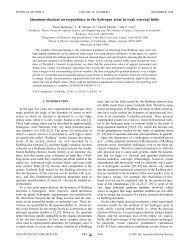
![Phase retrieval algorithms: a personal tour [Invited] - The Institute of ...](https://img.yumpu.com/25023725/1/190x249/phase-retrieval-algorithms-a-personal-tour-invited-the-institute-of-.jpg?quality=85)
